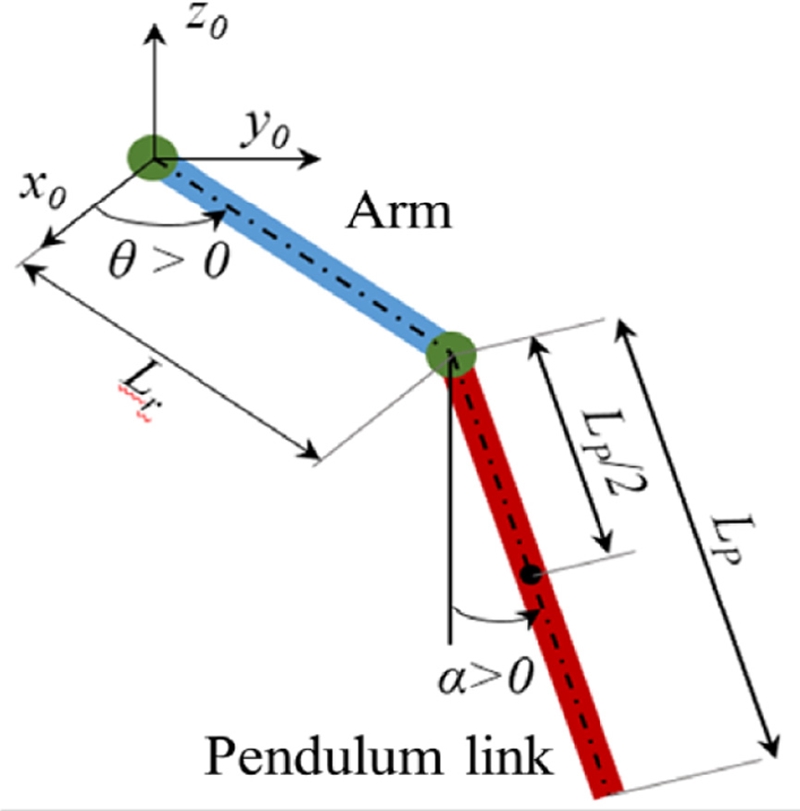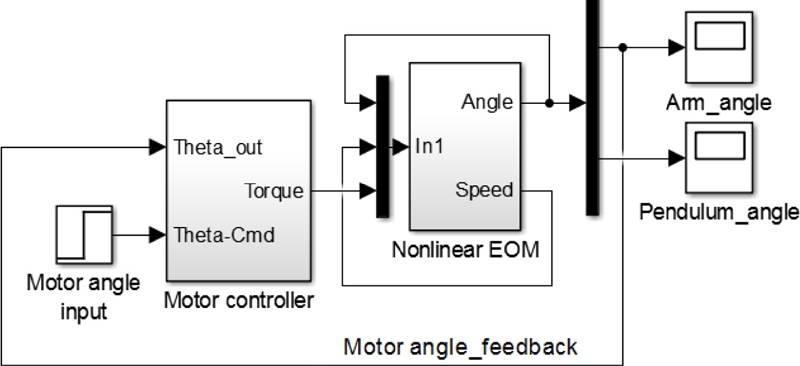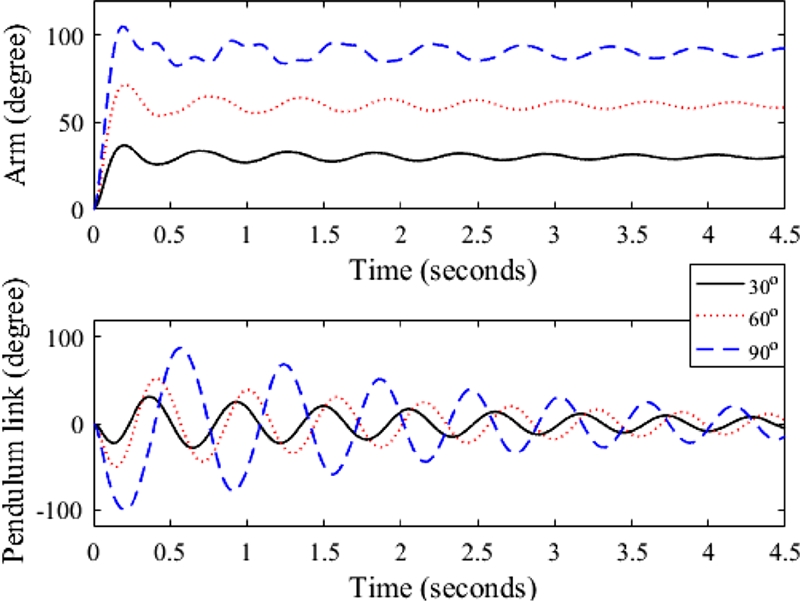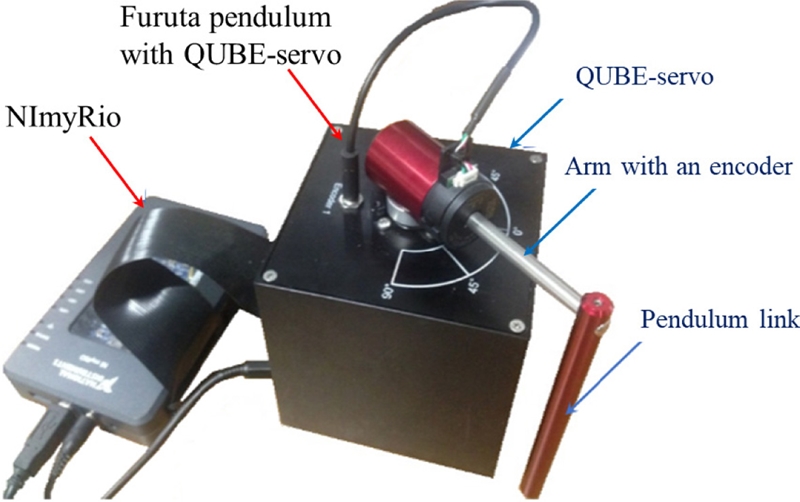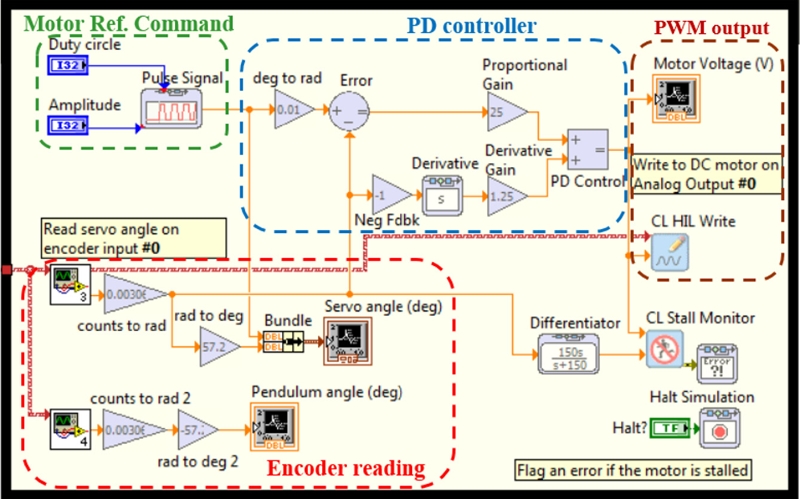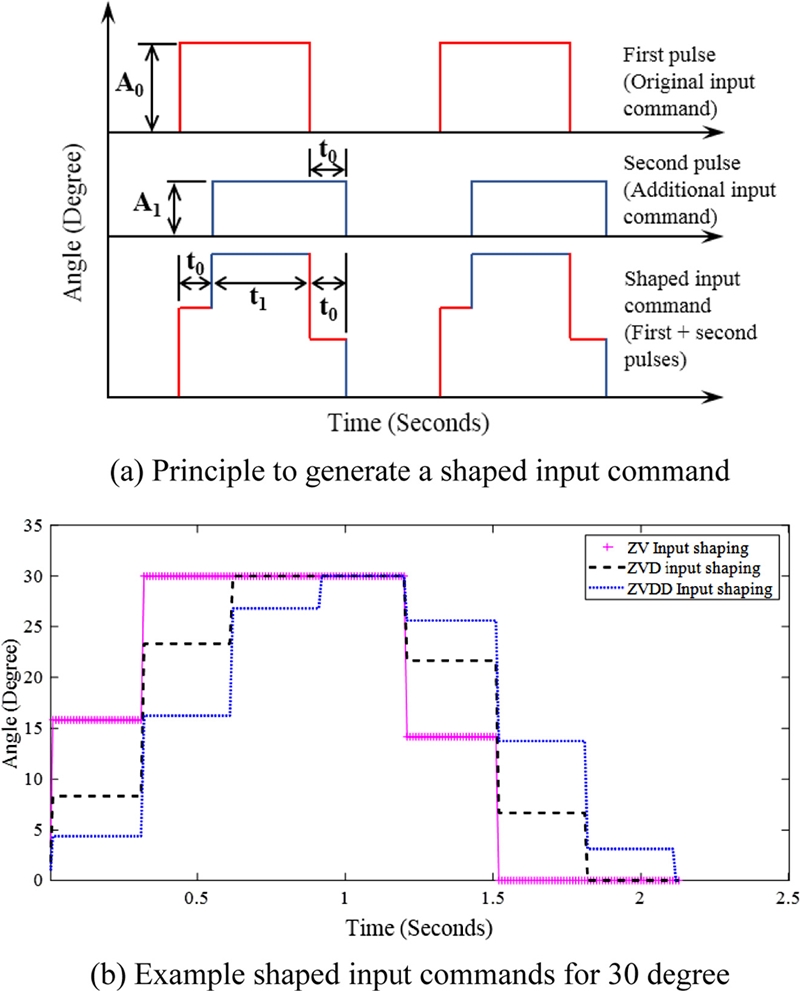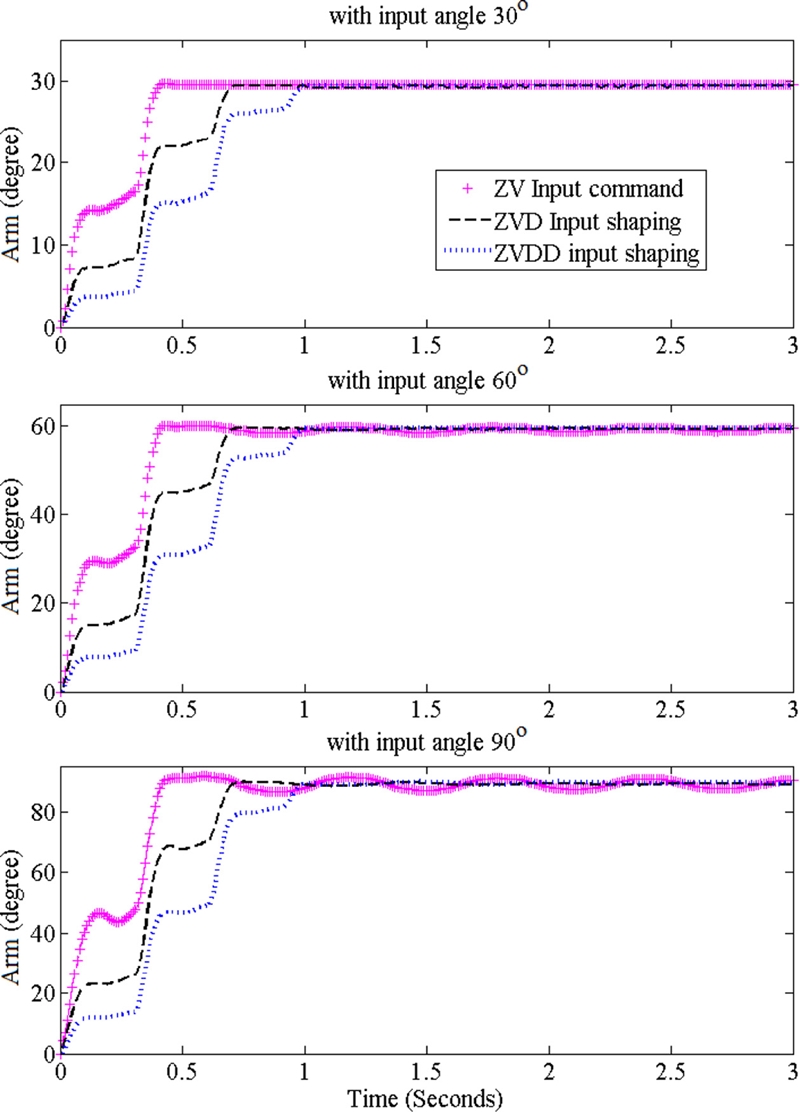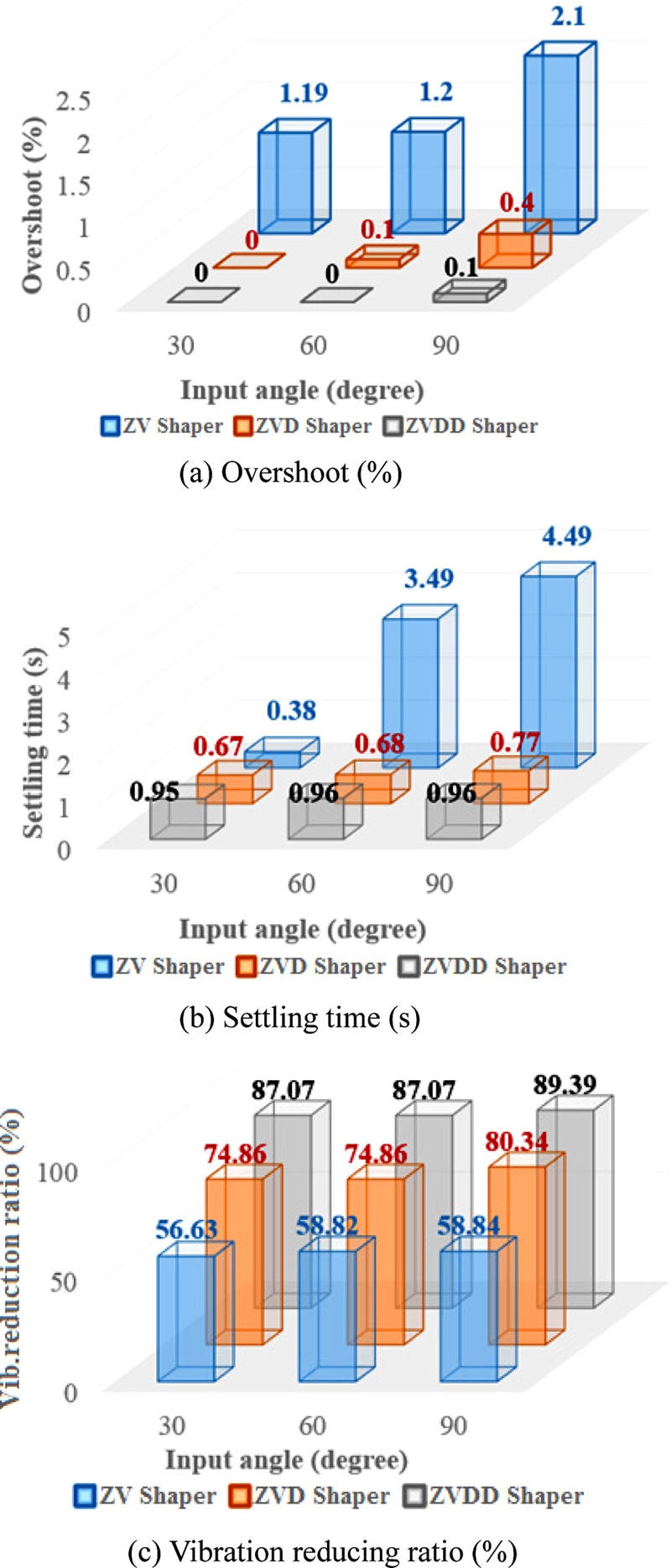
Evaluation of Input Shaping Methods for the Nonlinear Vibration System Using a Furuta Pendulum
Copyright © The Korean Society for Precision Engineering
This is an Open-Access article distributed under the terms of the Creative Commons Attribution Non-Commercial License (http://creativecommons.org/licenses/by-nc/3.0) which permits unrestricted non-commercial use, distribution, and reproduction in any medium, provided the original work is properly cited.
Abstract
There are many nonlinear vibration problems of mechanical structures because of various reasons such as geometric parameters, impact loads, or property of materials. One simple solution for the suppression of nonlinear structural vibration is input shaping that generates a command signal to cancel its vibration. However, a motion platform to evaluate the performance of input shapers for nonlinear vibration is rare. This paper presents the evaluation of input shaping methods for the nonlinear vibration system using a Furuta pendulum. First, the mathematical model of the Furuta pendulum is introduced and its nonlinear vibration characteristic is analyzed. Then, commands for canceling the nonlinear vibration of the Furuta pendulum are generated with various input shapers such as ZV, ZVD, and ZVDD. Finally, we illustrate the effects of input shapers on the nonlinear Furuta pendulum by comparing the pendulum overshoot, settling time, and vibration-reduction ratio. The Furuta pendulum is shown to be a good motion platform to evaluate input shaping methods for nonlinear vibration systems.
Keywords:
Nonlinear vibration, Input shaping, Furuta pendulum키워드:
비선형 진동, 입력 성형, 후루타 펜둘럼1. Introduction
Over decades, numerous approaches to suppress linear or nonlinear vibration systems have been studied.1-5 These approaches can be classified into three main categories. The first one is to fundamentally avoid the excitation source by introducing special kinematic structure or force balancing. The second one is to cut the vibration transfer path by adding some devices or changing structures. The last one is to actively control the vibration with sensor or actuators such as feedback and feedforward controls.
There are many nonlinear vibration problems of mechanical structures or systems caused by various factors such as geometry, load condition, and materials.6,7 Although nonlinear vibration problems could be dealt with linear approaches, nonlinear effects cannot be neglected under cases of substantial amplitude or excitation. That is, the system dynamic variation due to its nonlinearity should be tackled with robust or nonlinear control.8
A simple solution for vibration problem is input shaping, which generates command signal to cancel its own vibration.9-14 The effectiveness of input shaping has been proved in many engineering applications. However, numerical simulation or parameter estimation was required for input shaping of nonlinear vibration since input shaping is developed based on linear system theory.12,13 In addition, a motion platform to evaluate various input shapers for nonlinear vibration is very rare.
Furuta pendulum is a rotational inverted pendulum used to study complex nonlinear oscillation based on control theory.15-19 Furuta pendulum consists of a driven arm rotating in the horizontal plane and a pendulum attached to the arm that is free to rotate in the vertical plane. Consequently, Furuta pendulum is under-actuated and extremely nonlinear due to the gravitational forces and the coupling from the Coriolis and centripetal force. Many papers focused on swing-up control of Furuta pendulum considering its complex nonlinear features.
This paper presents evaluation of input shaping methods for the nonlinear vibration system using a Furuta pendulum. The Furuta pendulum of this paper is operated as a nonlinear motion platform at the stable uninverted position. First, the mathematical model of the Furuta pendulum is introduced and its nonlinear vibration characteristic is analyzed. Then, commands for cancelling the nonlinear vibration of the Furuta pendulum are generated with various input shapers such as ZV (Zero Vibration), ZVD (Zero Vibration Derivative), and ZVDD (Zero Vibration Double Derivative). Finally, we illustrate the effects of input shapers on the nonlinear Furuta pendulum by comparing the pendulum overshoot, settling time and vibration-reduction ratio. The Furuta pendulum is shown to be a good motion platform to evaluate input shaping methods for nonlinear vibration system.
2. Furuta Pendulum Model
2.1 Mathematical Model
Although Furuta pendulum is normally used to study complex nonlinear controls for swinging up the pendulum link into the inverted position, the Furuta pendulum of this study is a nonlinear motion platform of the under-actuated pendulum link swinging around the stable uninverted position.
Compared with a conventional pendulum based on linear motion and limited in space of rail, Furuta pendulum uses an unlimited rotational input motion. Schematic diagram of the Furuta pendulum is shown in Fig. 1. The arm of length Lr is driven by angle θ with a DC motor and one end of the arm is connected to the pendulum link of length LP. The arm angle θ and the pendulum angle α are zero at the uninverted vertical position of the pendulum and increase as it rotates in the counter-clockwise (CCW) direction.
Equations of motion (EOM) for the pendulum can be derived with Euler-Lagrange equation, as shown in Eq. (1).15 Kinetic energy T is the sum of kinetic energies of both the arm and the pendulum link. In addition, the potential energy is given by the potential of the pendulum link. F is the damping term related to the arm and the pendulum link, and u is input of motor. The resulting derived EOM of the Furuta pendulum has severe nonlinearities, as shown in Eq. (2). The motion of the arm is highly coupled with the pendulum link motion.
| (1) |
| (2) |
2.2 Nonlinear Vibration of Furuta Pendulum
Fig. 2 shows a simulation model consisting of a DC motor controller and the derived EOM of the Furuta pendulum. The parameters of the simulation model are summarized in Table 1. For the simplicity, the DC motor is approximated as a first order system with torque and time constants. In addition, a PD control is used to control the DC motor.
Simulations with various arm or motor reference commands are performed to investigate the nonlinear vibration characteristic of the Furuta pendulum. The resulting arm and pendulum link, for cases of motor reference commands of 30, 60 and 90 degrees, are shown in Fig. 3. As the reference arm angle increases, nonlinear effects such as frequency variation are also greatly affected. In particular, the vibration suppression is not simple in the case of large reference arm angle like 90 degrees. In addition, the vibration frequencies (The Inverse of Time between Following Peaks) and damping (Logarithmic Decrement of Following Peaks) of the pendulum link with various magnitudes of reference arm angles are shown in Fig. 4. The damping decreases as the reference arm angle increases and time passes by. On the other hand, the frequency increases as the reference arm angle decreases and time passes by. In particular, the abrupt changes of both vibration frequency and damping occur in the case of large reference arm angle like 90 degrees. That is, the Furuta pendulum is a suitable motion platform.
3. Experiments
3.1 Experimental Set-Up
Experimental set-up consists of Furuta pendulum with QUBE-Servo 20 and NI myRIO,21 as shown in Fig. 5. The Furuta pendulum consists of the QUBE-Servo with DC servo, an arm with an optical encoder and a pendulum link. The QUBE-Servo includes a brushed DC motor with an optical encoder, a PWM amplifier, and an interface module. The DC motor is directly controlled with NI myRIO or an embedded real-time hardware that has both analog and digital-in/out, FPGA and ARM Cortex-A9 processor.
A control system is built under NI Labview environment with a rapid control prototyping toolkit.22,23 The control system consists of motor reference command, PD controller, PWM output and encoder reading, as shown in Fig. 6. Series of pulse signals with different amplitudes and widths are generated for the motor reference commands or input shaping methods. In addition, a PD controller (KP = 25 and KD = 1.25) is used for DC motor servo control.
Based on vibration frequency and damping ratio, shaped input commands of ZV, ZVD and ZVDD are generated for the reference arm angle of 30, 60 and 90o, respectively. Set of pulse signals with different amplitudes and widths are combined for the shaped input commands, as shown in Fig. 7(a). The shaped input of the ZV consists of two pulses with different amplitudes and widths and the second pulse A1 applied with later time t0 cancels the vibration caused by the first pulse A0. The resulting shaped inputs of the ZV, ZVD, ZVDD for reference arm angle of 30o are illustrated in Fig. 7(b). The parameters of pulses are determined based on vibration frequency and damping of the Furuta pendulum. The equation for parameters of the shaped inputs commands of ZV, ZVD, ZVDD is illustrated in Table 2.
3.2 Results
Resulting vibrations of both the arm and the pendulum link with the shaped inputs are shown in Figs. 8 and 9, individually. The oscillation of the arm for 30o reference arm angle disappears with any kind of input shapers, whereas ZVD and ZVDD are more effective than ZV for the motor reference angles of 60 and 90o. The results of the pendulum link are even clearer, as shown from Fig. 7. The vibrations of the pendulum link are reduced dramatically with the input shapers. However, the ZV shaper has significant performance degradation compared with the ZVD and ZVDD shapers as the motor reference command increases and nonlinearity becomes severe.
Overshot, settling time and vibration-reduction ratio of the Furuta pendulum are evaluated and shown in Fig. 10. For the small reference arm angles (≤ 30o), all shapers show similar performances. However, ZVD and ZVDD shapers show a better performance of not only shorter settling time (≤ 1 s) and overshoot (≤ 0.5%) but also larger vibration-reduction ratio (≥ 75%) as the motor reference angle increases and nonlinearity becomes critical. The ZV shaper cannot effectively deal with parameter variations of the nonlinear vibration caused by large reference command.
4. Conclusion
This paper presents the evaluation of input shaping methods for the nonlinear vibration system using a Furuta pendulum. First, the mathematical model of the Furuta pendulum is introduced and its nonlinear vibration characteristic is analyzed. Then, reference commands for cancelling the vibration of the Furuta pendulum are generated with various input shapers such as ZV, ZVD and ZVDD. Finally, we illustrate the effects of input-shaping methods on the Furuta pendulum by comparing the pendulum overshoot, settling time and vibration reduction ratio. The Furuta pendulum is proved to be a good motion platform to evaluate input shaping methods for nonlinear vibration system.
NOMENCLATURE
| Ai : | Magnitude of ith command |
| Dr : | Damper ratio of arm |
| DP : | Damper ratio of pendulum link |
| g : | Gravitational acceleration |
| Jr : | Inertia moment of arm |
| JP : | Inertia moment of pendulum link |
| K : | Motor torque constant |
| Lr : | Length of arm |
| LP : | Length of pendulum link |
| mP : | Mass of pendulum link |
| Q : | Input of system |
| T : | Kinetic energy of system |
| Tmr : | Kinetic energy of arm |
| Tmp : | Kinetic energy of pendulum link |
| ti : | Starting time of ith command |
| u : | Reference arm angle |
| α : | Angle of pendulum link |
| θ : | Angle of arm |
| П : | Potential energy |
| Φ : | Damping term |
| τ : | Motor time constant |
| ωd : | Damped natural frequency |
| ζ : | Damping ratio |
Acknowledgments
This work was supported by The University of Danang, University of Science and Technology (No. T2020-02-03).
REFERENCES
-
Fuller, C. C., Elliott, S., and Nelson, P. A., “Active Control of Vibration,” Academic Press, 1996.
[https://doi.org/10.1016/B978-012269440-0/50007-8]

-
Alkhatib, R. and Golnaraghi, M., “Active Structural Vibration Control: A Review,” Shock and Vibration Digest, Vol. 35, No. 5, pp. 367-383, 2003.
[https://doi.org/10.1177/05831024030355002]

-
Lu, Z., Wang, Z., Zhou, Y., and Lu, X., “Nonlinear Dissipative Devices in Structural Vibration Control: A Review,” Journal of Sound and Vibration, Vol. 423, No. 9, pp. 18-49, 2018.
[https://doi.org/10.1016/j.jsv.2018.02.052]

-
Yoo, S. J. and Ahn, H. J., “Software-Based Integral Product Architecture for Modular Motion Control System of a RFC Linear Motor Motion Stage: Model-Based DOB for Residual Vibration Suppression,” International Journal of Precision Engineering and Manufacturing, Vol. 21, No. 2, pp. 203-209, 2020.
[https://doi.org/10.1007/s12541-019-00212-y]

-
Li, L., Song, G., and Ou, J., “Nonlinear Structural Vibration Suppression Using Dynamic Neural Network Observer and Adaptive Fuzzy Sliding Mode Control,” Journal of Vibration and Control, Vol. 16, No. 10, pp. 1503-1526, 2010.
[https://doi.org/10.1177/1077546309103284]

-
Correa, J. C., “Parameter Identification and Monitoring of Mechanical Systems under Nonlinear Vibration,” Woodhead Publishing, pp. 35-53, 2014.
[https://doi.org/10.1533/9781782421665.35]

- Srinivasan, P., “Nonlinear Mechanical Vibrations,” Wiley, 1st Ed., 1996.
- Wagg, D. and Neild, S., “Nonlinear Vibration with Control,” Springer International Publishing Switzerland, 2016.
-
Singhose, W., “Command Shaping for Flexible Systems: A Review of the First 50 Years,” International Journal of Precision Engineering and Manufacturing, Vol. 10, No. 4, pp. 153-168, 2009.
[https://doi.org/10.1007/s12541-009-0084-2]

-
Tuttle, T. D. and Seering, W. P., “Experimental Verification of Vibration Reduction in Flexible Spacecraft Using Input Shaping,” Journal of Guidance, Control, and Dynamics, Vol. 20, No. 4, pp. 658-664, 1997.
[https://doi.org/10.2514/2.4128]

-
Maghsoudi, M. J., Mohamed, Z., Sudin, S., Buyamin, S., Jaafar, H., et al., “An Improved Input Shaping Design for an Efficient Sway Control of a Nonlinear 3D Overhead Crane with Friction,” Mechanical Systems and Signal Processing, Vol. 92, pp. 364-378, 2017.
[https://doi.org/10.1016/j.ymssp.2017.01.036]

- Kim, B. G. and Hong, S. W., “Input Shaper Design for Tower Crane in Consideration of Nonlinear Coupled Motions,” Journal of the Korean Society for Precision Engineering, Vol. 26, No. 9, pp. 88-95, 2009.
-
Kim, D. H., Sung, Y. G., and Jang, W. S., “Learning Input Shaping Control with Parameter Estimation for Nonlinear Actuators,” Transactions of the Korean Society of Mechanical Engineers A, Vol. 35, No. 11, pp. 1423-1428, 2011.
[https://doi.org/10.3795/KSME-A.2011.35.11.1423]

-
Hwang, K. J., Jeong, J. S., and Ahn, H. J., “Input-Shaping Methods for a Linear Motor Motion Stage with a Passive RFC (Reaction Force Compensation) Mechanism,” Journal of the Korean Society for Precision Engineering, Vol. 34, No. 12, pp. 897-902, 2017.
[https://doi.org/10.7736/KSPE.2017.34.12.897]

-
Furuta, K., Yamakita, M., and Kobayashi, S., “Swing-Up Control of Inverted Pendulum Using Pseudo-State Feedback,” Proceedings of the Institution of Mechanical Engineers, Part I: Journal of Systems and Control Engineering, Vol. 206, No. 4, pp. 263-269, 1992.
[https://doi.org/10.1243/PIME_PROC_1992_206_341_02]

-
La Hera, P. X., Freidovich, L. B., Shiriaev, A. S., and Mettin, U., “New Approach for Swinging Up the Furuta Pendulum: Theory and Experiments,” Mechatronics, Vol. 19, No. 8, pp. 1240-1250, 2009.
[https://doi.org/10.1016/j.mechatronics.2009.07.005]

-
Aguilar-Avelar, C. and Moreno-Valenzuela, J., “A Composite Controller for Trajectory Tracking Applied to the Furuta Pendulum,” ISA Transactions, Vol. 57, pp. 286-294, 2015.
[https://doi.org/10.1016/j.isatra.2015.02.009]

-
Garćıa-Alarćon, O., Puga-Guzḿan, S., and Moreno-Valenzuela, J., “On Parameter Identification of the Furuta Pendulum,” Procedia Engineering, Vol. 35, pp. 77-84, 2012.
[https://doi.org/10.1016/j.proeng.2012.04.167]

-
Aracil, J., Acosta, J., and Gordillo, F., “A Nonlinear Hybrid Controller for Swinging-Up and Stabilizing the Furuta Pendulum,” Control Engineering Practice, Vol. 21, No. 8, pp. 989-993, 2013.
[https://doi.org/10.1016/j.conengprac.2013.04.001]

- Quanser, “QUBE-Servo Experiment for Labview Users-Workbook,” https://www.coursehero.com/file/34003943/QUBEServo-Workbook-for-LabVIEW-Studentpdf, / (Accessed 27 OCTOBER 2020)
- National Instruments, “myRIO Student Embedded Device,” https://www.ni.com/en-vn/shop/select/myrio-student-embedded-device, (Accessed 14 OCTOBER 2020)
- National Instruments, “LabVIEW-User Manual,” http://www.ni.com/pdf/manuals/373427j.pdf, (Accessed 27 OCTOBER 2020)
- Engineer Ambitiously, “Quanser Rapid Control Prototyping Toolkit,” http://sine.ni.com/nips/cds/view/p/lang/en/nid/211216, (Accessed 14 OCTOBER 2020).

Received a Ph.D. degree from Soongsil University, Korea in 2018. He was a research associate in the IMSLab-Soongsil University and is currently a researcher/lecturer at the Faculty of Mechanical Eng., University of Science and Technology- The University of Danang. Dr. Pham’s research interests are in the area of mechatronics, control & precision machine design, sustainable design &manufacturing, applications of Nanomaterials.
E-mail: ducpham@dut.udn.vn, ducpham2014@gmail.com

Received B.S., M.S. and Ph.D. degrees from Seoul national university, Korea in 1995, 1997 and 2001, respectively. He was research associate in University of Virginia, 2002 and is currently a professor at School of Mechanical Eng., Soongsil University. Dr. Ahn’s research interests are in the area of mechatronics, sensors, actuators, control and precision machine design.
E-mail: ahj123@ssu.ac.kr

